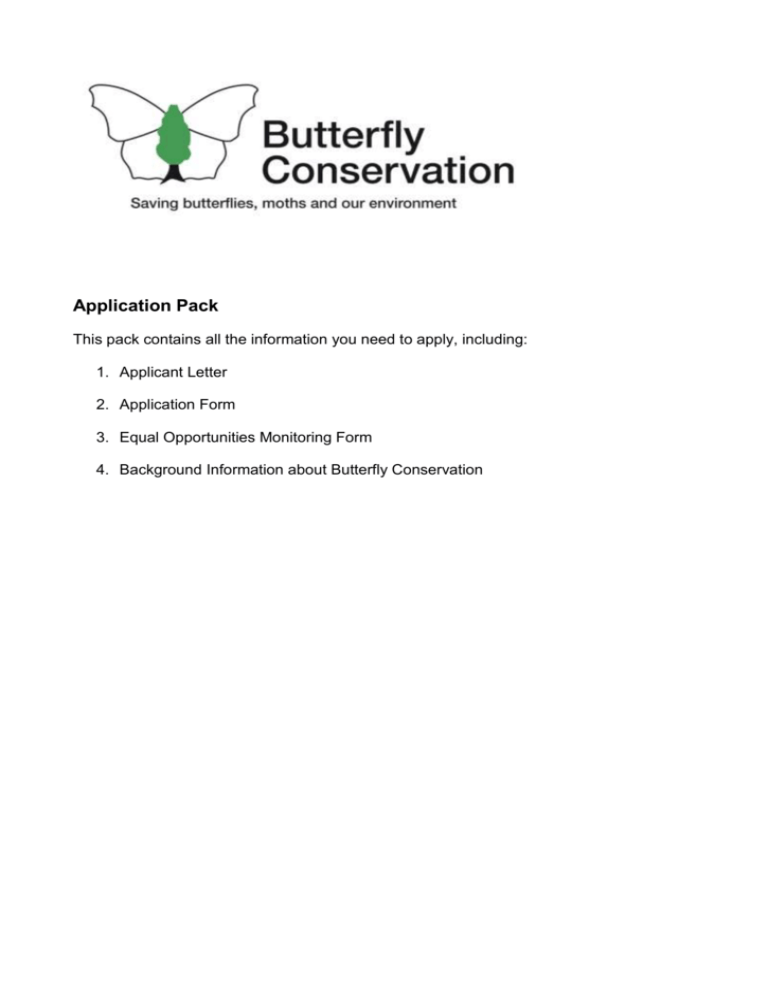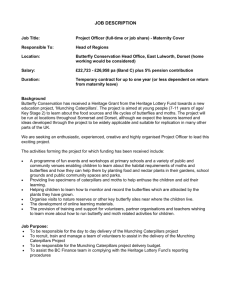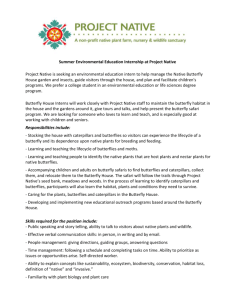Application Pack - Butterfly Conservation
advertisement

Application Pack This pack contains all the information you need to apply, including: 1. Applicant Letter 2. Application Form 3. Equal Opportunities Monitoring Form 4. Background Information about Butterfly Conservation Dear Applicant Application Guidance Thank you for your interest in our advertised vacancy. We are committed to the promotion of equality of opportunity in all our employment practices. We require the same range of information from all candidates and will not, therefore, accept CVs in place of an application form. The Equal Opportunities monitoring form is used for statistical purposes only and will not be seen by any manager involved in making the appointment. Your application form plays an important part in our selection process. The information you include will decide whether or not you are short-listed for interview. Please ensure that your completed form relates as closely as possible to the requirements of the job, detailed in the Job Description, and to the essential requirements of the Person Profile. If you require any further details regarding this position, please call 01929 400209. Your completed application form (signed, hard copy) and Equal Opportunities monitoring form should be returned, marked confidential, before noon on the listed closing date to: Human Resources Butterfly Conservation, Manor Yard, East Lulworth, Wareham, Dorset BH20 5QP Application forms can be emailed to hr@butterfly-conservation.org to arrive before the closing date but this should be followed up with a signed hard copy sent by post to the above address. Any applications arriving after the deadline will not normally be considered for short-listing. If you have been selected for interview, you will be contacted with further details and will be asked to bring with you to the interview a document that proves your entitlement to work in the UK, for example your passport. If you have not heard from us by the interview date, please assume that your application has been unsuccessful on this occasion. We look forward to receiving your application and wish you every success. Yours sincerely Julie Williams (Mrs) Deputy Chief Executive Application Form Please complete this form in type or black ink, sign the application form and send it to: Human Resources, Butterfly Conservation, Manor Yard, East Lulworth, Wareham, Dorset, BH20 5QP POSITION APPLIED FOR: PERSONAL DETAILS Mr/Mrs/Ms/Other (State): Work Telephone No: Surname: May we ring you at work? First Names: Home Telephone No: Address: Mobile Telephone No: Yes/No E-mail Address: REFERENCES - Employment Related Please give names and addresses of two people to whom we may apply for a reference: Reference 1 Name: Reference 2 Name: Address: Address: Telephone No: Telephone No: Relationship: Relationship: May we approach the above without further reference to you prior to an interview? Yes/No Are you likely to be available on the interview date? Yes/No Have you previously applied for a position with Butterfly Conservation? If yes, please give details: Yes/No Do you have any criminal convictions? If yes, please give details: Yes/No PRESENT EMPLOYMENT (or if now unemployed, details of last employment): Name and Address of Employer: Job Title: Present Salary: From (Month/Year): To (Month/Year): Please give a brief description of the job and your responsibilities: (Continue on a separate sheet if necessary) What notice period do you have to give? (If applicable): EDUCATION AND QUALIFICATIONS - Please give details of your education and qualifications obtained: Schools/Colleges etc: From: (Month/Year) To: (Month/Year) Examinations Passed Qualifications Obtained Details of any further qualifications obtained or relevant courses attended: Details of membership of professional/trade organisation: Do you hold a full driving licence? Do you have any points on your licence? (please state) Yes/No EMPLOYMENT HISTORY - Please give details of your previous employment (starting from the most recent): Name of Employer INTERESTS From: (Month/Year) To: (Month/Year) Salary: Job title, description of the post and reason for leaving: ADDITIONAL INFORMATION - Please set out any additional information (including relevant experience) to demonstrate that you meet the job description and to show your suitability for the post. Use one extra sheet if necessary: I declare that the information provided in this application form is, to the best of my knowledge, correct and, if I am appointed, will form part of my contract of employment. Signed: Date: Butterfly Conservation. Company Limited by guarantee, registered in England (2206468) Registered Office: Manor Yard, East Lulworth, Wareham, Dorset BH20 5QP. Charity registered in England & Wales (254937) and in Scotland (SCO39268) Equal Opportunities Monitoring Form Butterfly Conservation will seek to ensure that all existing and potential employees are given equal opportunities. We want to make sure we are an equal opportunities employer in practice, which is why we monitor our recruitment procedures. Butterfly Conservation will seek to ensure that no application for employment is disadvantaged by conditions or requirements which cannot be justified. In order to help us monitor the effectiveness of our Equal Opportunities Policy (and for no other reason) you are asked to provide the information requested below. This information is confidential and does not form part of your application. This sheet will be detached from your application form upon receipt and the information will not be taken into account when making the appointment. Name: Post applied for: Date: Where did you see this post advertised? Please tell us about yourself: answering these questions will help us to ensure our recruitment and employment processes are fair to all and recognise the diversity needs of our workforce. However, we appreciate that how people are defined is a personal choice and understand if you prefer not to respond to some of these questions. Age Please tick to indicate the age group you are in: 16 – 24 25 – 29 30 – 39 40 – 49 50 – 59 60 – 74 Prefer not to say Gender If you are undergoing the process of gender reassignment, please tick the box that applies to your future gender: Male Female Prefer not to say Sexual Orientation Heterosexual/straight Bisexual Gay man Gay woman/lesbian Prefer not to say Ethnic Origin Please tick or state your ethnic origin below. White British Welsh Gypsy / Traveller Mixed White & Black Caribbean White and Asian Asian or Asian British Indian Bangladeshi Black or Black British African Other ethnic group Arab Prefer not to say Irish English Other White background Scottish Northern Irish White & Black African Other Mixed background Pakistani Chinese Other Asian background Caribbean Other Black background Any other ethnic group: Religion or Belief How would you describe your religion or belief? My religion or belief is I have no religion or belief I prefer not to say Disability People with a disability or a health condition are entitled by law to ‘reasonable adjustments’ during the recruitment process. We are interested in any disability or health condition that may require such a reasonable adjustment. Do you consider yourself to have a disability or a health condition? Yes / No The Equality Act 2010 defines disability as a physical or mental impairment which has a substantial and long-term adverse effect on your ability to carry out normal day-to-day activities which has lasted or is expected to last, at least 12 months. If “Yes”: What adjustments do you require in order to attend an interview? If “Yes”: What adjustments would you require in order to help you carry out this job? Prefer not to say Thank you for completing this form. Please return it along with your completed application. BACKGROUND INFORMATION Butterfly Conservation was founded in 1968. It is a registered charity and limited company, whose mission is the conservation of butterflies, moths and our environment. Butterfly Conservation is the largest insect conservation society in Europe and works closely with our partners in Butterfly Conservation Europe. Britain has 57 resident butterfly species and there are half a dozen or more that visit us regularly from abroad and which breed here in warm weather. Five butterflies have become extinct in Britain in the last 150 years – the Large Copper, Mazarine Blue, Black-veined White, Large Blue and Large Tortoiseshell. The Large Blue has been successfully re-introduced, but requires continual conservation measures to survive. Data gathered by Butterfly Conservation shows that over three-quarters of our resident butterflies are in decline and 24 are threatened with extinction. Our results show that butterflies are more highly threatened than other popular groups such as birds and plants. Moths have suffered similar declines and around two-thirds of common species have declined in recent decades. In total, over 150 species are considered threatened. As moths are important prey items for other species, this demonstrates a widespread crisis in wildlife in our countryside and towns. These rapid and alarming declines have arisen primarily because of habitat destruction and changing management following changes in agriculture and forestry practices. The decline of traditional woodland management, the drainage of wetlands, industrial, housing and road developments and peat extraction have all taken their toll. Since the 1940s we have lost 40% of our natural broad-leaved woodlands, 80% of our chalk pasture, 200,000 miles of hedgerow, over 20 million elm trees and over 95% of flower-rich hay and grazing meadows. In many places suitable habitats are now so isolated that there is no chance of recolonisation when existing populations of a species die out. Climate change is having a profound affect on butterflies and moths and many species are spreading northwards as average temperature rises. However, many species are threatened by climate change, especially those living in coastal habitats and in mountains or wetland habitats. Even our common butterflies have become severely reduced in number, and for many people butterflies are no longer an intrinsic part of summer days in gardens and the countryside. Their loss is symptomatic of the continuing overexploitation of our environment. ABOUT THE ORGANISATION People Until 1990 Butterfly Conservation was entirely managed and run by volunteers. In 1990 the charity established a Head Office in Essex. A Conservation Office was established in Dorset in 1993. In December 2000, the Head Office was moved to East Lulworth, Dorset. Butterfly Conservation’s activity has grown rapidly over the last two decades, with accompanying increase in staff. Over 70 staff now work from a network of offices around the UK, including an office in Scotland, Wales, N. Ireland, and in several regions of England. Butterfly Conservation’s Chief Executive is Dr Martin Warren and other senior officers are Julie Williams (Deputy Chief Executive), Dr Nigel Bourn (Director of Science & Policy), Dr Sam Ellis (Director of Conservation & Regions) and Paul Kirkland (Director, Scotland). Butterfly Conservation is managed by a Council, which meets four times a year. Its Chair is Dr Jim Asher who took office in 2014. There are currently three sub-committees of Council, the Conservation Strategy Committee, Governance Committee and Investment Committee. The President of Butterfly Conservation is Sir David Attenborough, the celebrated wildlife broadcaster and writer, and among our Vicepresidents we are fortunate to have Alan Titchmarsh, Chris Packham and Mike Dilger. A Growing Network Butterfly Conservation now has over 28,000 members and 31 active local branches throughout the UK and a European Interest Group. Branches are managed by voluntary committees and carry out local conservation and other work, under advice and guidance from the charity’s staff. Through our branch network, thousands of volunteers carry out practical conservation tasks, the management of reserves and other important sites, recording and monitoring of butterflies and moths, and field trips. Our volunteers contribute work worth £10.54 million during the year, equivalent to 765 full-time staff. HOW WE WORK The strategic direction, key objectives and targets of Butterfly Conservation are set out in the 2020 Vision. This is reviewed annually by Council and senior staff. The strategic aims are: 1. Halt and reverse the decline of threatened species if butterflies and moths in the UK. 2. Increase the numbers of butterflies and moths across the wider landscape. 3. Maintain efficient, scientifically robust recording and monitoring schemes making the best use if modern technology and continuing to influence Government and wider decision-making on the environment for the benefit of all species. 4. Raise widespread awareness amongst the public and especially young people, about the role of butterflies and moths in contributing to a healthy environments and the need to conserve them now and in the future. 5. Play a major role in establishing sustainable resourcing for Butterfly Conservation Europe to fulfil a long-term role of conserving butterflies and moths across Europe. 6. Use our influence to support wider initiatives to conserve a healthy environment and ensure a secure future for both wildlife and people. 7. Significantly expand our member and supporter base to generate sustainable funds and give Butterfly Conservation a stronger voice at national and local levels. Our aspiration: 100,000 members /supporters. 8. Continue to develop our volunteer, branch and external networks so that they contribute significantly to all the above outcomes as well as addressing local needs. 9. Secure the substantial increase in funding and other resources needed to sustain Butterfly Conservation’s work in the long term. Our aspiration: £10 million p.a. matched by volunteer effort equivalent to £20 million p.a. In order to direct and prioritise conservation activities, we have drawn up a series of action plans for threatened species and a series of Regional Action Plans. These are intended to be a major contribution to the Government’s UK Biodiversity Action Plan and the International Convention of Biological Diversity. A total of 24 butterflies and 152 moths are listed as Priority Species in the UK Biodiversity Action Plan and Butterfly Conservation has been appointed as Lead Partner for their conservation. Our efforts to conserve these species are focussed at a landscape scale, often involving collaborative projects with partner organisations. Recording A central aspect of our work is the gathering of accurate recording and monitoring information on the state of butterflies and moths. The Butterflies for the New Millennium recording scheme is the largest of its kind in the world with over 10 million records collated. The UK Butterfly Monitoring Scheme gathers data on population trends on a network of over 1,000 sites, based on counts from butterfly transects. The results have been used to create a Butterfly Indicator that has been adopted by Government as an indicator of the state of the environment. The National Moth Recording Scheme was established in 2007 and has gathered nearly 19 million records on the UK’s larger moths. A Provisional Atlas of Larger Moths was produced in 2010. Reserves Butterfly Conservation also protects important butterfly and moth populations through the establishment of reserves. These may be owned or leased and are mostly managed by our local Branches and volunteers. We currently have 35 reserves covering 785 ha, including several reserves where we are restoring habitat from former arable land. Publications An informative and colour illustrated magazine for members, Butterfly, is published three times a year. We also produce a wide range of leaflets and booklets as well as scientific papers and reports. Local Branches produce their own regular newsletters providing general information and articles of particular local interest. For Further Information Head Office Butterfly Conservation Manor Yard East Lulworth Wareham Dorset BH20 5QP Tel: 01929 400209 Fax: 01929 400210 Email: hr@butterfly-conservation.org www.butterfly-conservation.org @savebutterflies facebook.com/savebutterflies Butterfly Conservation. Company limited by guarantee, registered in England (2206468). Registered Office: Manor Yard, East Lulworth, Wareham, Dorset, BH20 5QP. Charity registered in England & Wales (254937) and in Scotland (SCO39268) Updated 13 October 2015








